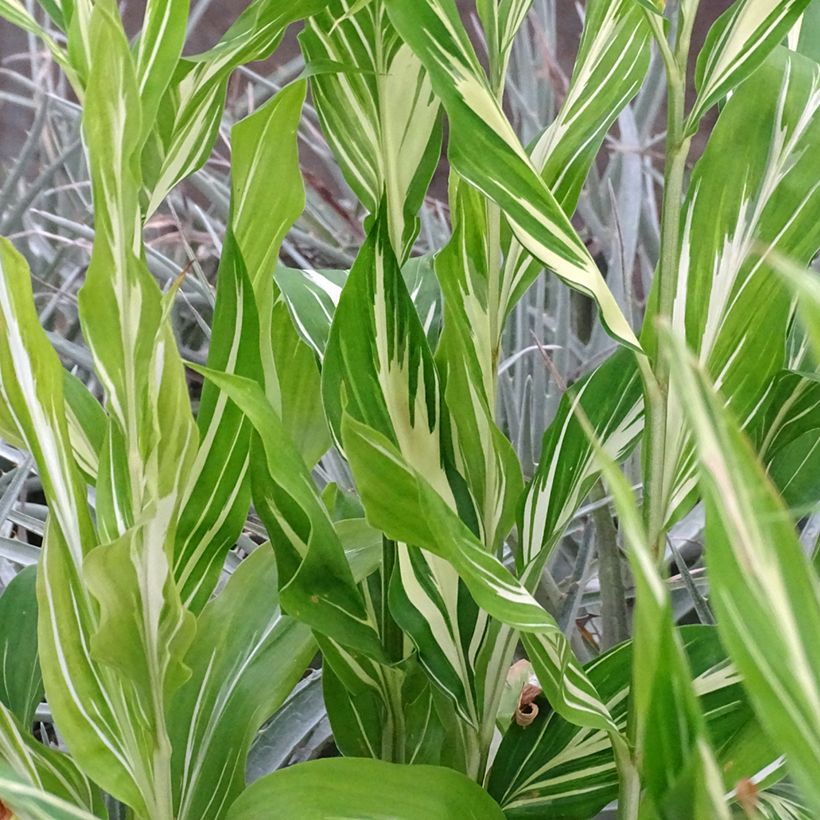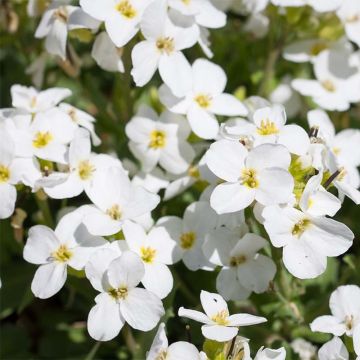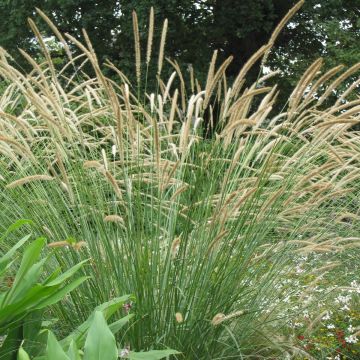

Gingembre japonais - Zingiber mioga Dancing Crane


Gingembre japonais - Zingiber mioga Dancing Crane


Gingembre japonais - Zingiber mioga Dancing Crane
Zingiber mioga Dancing Crane
Zingiber mioga Dancing Crane
Japanese Ginger, Myoga Ginger
This item cannot be shipped to the selected country
Delivery charge from 6,90 €
More information
Shipping country:
-
-
-
-
-
-
-
-
-
-
-
-
-
-
-
-
-
-
-
-
-
-
-
-
-
-
-
-
-
-
-
-
Schedule delivery date,
and select date in basket
This plant carries a 12 months recovery warranty
More information
We guarantee the quality of our plants for a full growing cycle, and will replace at our expense any plant that fails to recover under normal climatic and planting conditions.
From 7,90 € for pickup delivery and 6,90 € for home delivery
Express home delivery from 8,90 €.
Would this plant suit my garden?
Set up your Plantfit profile →
Description
Zingiber mioga 'Dancing Crane' is a very beautiful form of Japanese ginger with variegated cream-white foliage, even more decorative than the type, and just as easy to grow in the garden under our climate. This perennial plant is both highly ornamental with its lush foliage and unique with its tender yellow flowers that emerge at the base of the stems in summer. It is also useful in cooking to flavour Asian dishes. In Japan, the unopened flower buds are most often consumed. They have a flavour similar to that of medicinal ginger without the spicy note. Its rhizomes and young shoots are also edible. This ginger is hardy down to -15°C (5°F) with protective mulch. It is grown in partial shade, both in the ground and in pots.
'Dancing Crane' is a Japanese selection from the Gotemba nursery. The wild, non-variegated form is native to the moist valleys of southern China to central Japan. Zingiber mioga 'Dancing Crane' is a rhizomatous perennial plant belonging to the Zingiberaceae family. Its annual vegetation typically emerges from the ground in April and disappears in late autumn. The underground rhizome produces thin stems each year, bearing long, lanceolate leaves of a light and vibrant green, variegated with white to cream, somewhat reminiscent of those of aspidistra. They reach a length of 20 to 40cm (8 to 16in), with a width of 4 to 6cm (2in). The clump expands year after year, reaching 50 to 60cm (20 to 24in) in all directions. This ginger is a remarkable aromatic plant. Its inflorescences appear in summer, at ground level. They are ellipsoid in shape and measure 5 to 7cm (2 to 3in). The flowers emerge from scaly, elongated, pointed buds that open one after the other, between each scale. They are small (2 to 3cm (1in)), tubular, and a very pale-yellow. The foliage emits a subtle scent, noticeable when crushed. All parts of the plant are edible, but the flower buds are mainly used in traditional Japanese cuisine.
Zingiber mioga 'Dancing Crane' is ideal for adding an exotic, vibrant, and lush touch to the garden. Planted in partial shade, along with hedychiums and colocasia, the effect will be truly enchanting! It can also be placed in a large pot, or even in the vegetable garden alongside aromatic plants, but in a semi-shaded area with consistently moist soil.
In cooking, the flower buds are used as a condiment to enhance the flavour of dishes. They are harvested from July to September, as they appear. The inflorescences are finely sliced and added to the dish at the end of cooking, to preserve their delicate aroma. It is also possible to blanch these buds like salads. As soon as they appear, cover them with a 5cm (2in) layer of sifted soil. Harvest them after 8 to 10 days. Zingiber mioga is also widely used in Asian pharmacopoeia.
Report an error about the product description
Zingiber mioga Dancing Crane in pictures


Flowering
Foliage
Plant habit
Botanical data
Zingiber
mioga
Dancing Crane
Zingiberaceae
Japanese Ginger, Myoga Ginger
West Asia
Other Perennials A to Z
Planting and care
'Dancing Crane' is easy to grow in open ground or in pots. Plant it after the last frost, in a semi-shaded or possibly fully shaded position, sheltered from the wind. It needs well-worked soil, cleared of any small stones or pebbles, lightened with leaf compost, remaining moist but well-drained to prevent the rhizome from rotting in waterlogged soil in winter. It is not demanding on the nature of the soil, but it is preferable to avoid limestone soils. The rhizome cannot tolerate dry soils. Mulching in summer helps to effectively retain soil moisture. You can plant your rhizomes in pots, where they will need to be regularly watered, but not excessively throughout the growing season. Apply a little liquid fertiliser every two weeks, from June to September. Remove the flowers as soon as they appear to use them in cooking. Outdoor cultivation poses no problems. In cool regions, mulch the soil to protect it in winter. Apply compost or well-decomposed manure every year in spring. Take care to protect the plant from slugs and snails that are fond of young shoots and flower buds. This plant has no other enemies.
Multiplication: divide the stumps in spring by taking a portion of rhizome with a dormant bud (an eye).
Planting period
Intended location
Care
This item has not been reviewed yet - be the first to leave a review about it.
Shade-loving perennials
Haven't found what you were looking for?
Hardiness is the lowest winter temperature a plant can endure without suffering serious damage or even dying. However, hardiness is affected by location (a sheltered area, such as a patio), protection (winter cover) and soil type (hardiness is improved by well-drained soil).

Photo Sharing Terms & Conditions
In order to encourage gardeners to interact and share their experiences, Promesse de fleurs offers various media enabling content to be uploaded onto its Site - in particular via the ‘Photo sharing’ module.
The User agrees to refrain from:
- Posting any content that is illegal, prejudicial, insulting, racist, inciteful to hatred, revisionist, contrary to public decency, that infringes on privacy or on the privacy rights of third parties, in particular the publicity rights of persons and goods, intellectual property rights, or the right to privacy.
- Submitting content on behalf of a third party;
- Impersonate the identity of a third party and/or publish any personal information about a third party;
In general, the User undertakes to refrain from any unethical behaviour.
All Content (in particular text, comments, files, images, photos, videos, creative works, etc.), which may be subject to property or intellectual property rights, image or other private rights, shall remain the property of the User, subject to the limited rights granted by the terms of the licence granted by Promesse de fleurs as stated below. Users are at liberty to publish or not to publish such Content on the Site, notably via the ‘Photo Sharing’ facility, and accept that this Content shall be made public and freely accessible, notably on the Internet.
Users further acknowledge, undertake to have ,and guarantee that they hold all necessary rights and permissions to publish such material on the Site, in particular with regard to the legislation in force pertaining to any privacy, property, intellectual property, image, or contractual rights, or rights of any other nature. By publishing such Content on the Site, Users acknowledge accepting full liability as publishers of the Content within the meaning of the law, and grant Promesse de fleurs, free of charge, an inclusive, worldwide licence for the said Content for the entire duration of its publication, including all reproduction, representation, up/downloading, displaying, performing, transmission, and storage rights.
Users also grant permission for their name to be linked to the Content and accept that this link may not always be made available.
By engaging in posting material, Users consent to their Content becoming automatically accessible on the Internet, in particular on other sites and/or blogs and/or web pages of the Promesse de fleurs site, including in particular social pages and the Promesse de fleurs catalogue.
Users may secure the removal of entrusted content free of charge by issuing a simple request via our contact form.
The flowering period indicated on our website applies to countries and regions located in USDA zone 8 (France, the United Kingdom, Ireland, the Netherlands, etc.)
It will vary according to where you live:
- In zones 9 to 10 (Italy, Spain, Greece, etc.), flowering will occur about 2 to 4 weeks earlier.
- In zones 6 to 7 (Germany, Poland, Slovenia, and lower mountainous regions), flowering will be delayed by 2 to 3 weeks.
- In zone 5 (Central Europe, Scandinavia), blooming will be delayed by 3 to 5 weeks.
In temperate climates, pruning of spring-flowering shrubs (forsythia, spireas, etc.) should be done just after flowering.
Pruning of summer-flowering shrubs (Indian Lilac, Perovskia, etc.) can be done in winter or spring.
In cold regions as well as with frost-sensitive plants, avoid pruning too early when severe frosts may still occur.
The planting period indicated on our website applies to countries and regions located in USDA zone 8 (France, United Kingdom, Ireland, Netherlands).
It will vary according to where you live:
- In Mediterranean zones (Marseille, Madrid, Milan, etc.), autumn and winter are the best planting periods.
- In continental zones (Strasbourg, Munich, Vienna, etc.), delay planting by 2 to 3 weeks in spring and bring it forward by 2 to 4 weeks in autumn.
- In mountainous regions (the Alps, Pyrenees, Carpathians, etc.), it is best to plant in late spring (May-June) or late summer (August-September).
The harvesting period indicated on our website applies to countries and regions in USDA zone 8 (France, England, Ireland, the Netherlands).
In colder areas (Scandinavia, Poland, Austria...) fruit and vegetable harvests are likely to be delayed by 3-4 weeks.
In warmer areas (Italy, Spain, Greece, etc.), harvesting will probably take place earlier, depending on weather conditions.
The sowing periods indicated on our website apply to countries and regions within USDA Zone 8 (France, UK, Ireland, Netherlands).
In colder areas (Scandinavia, Poland, Austria...), delay any outdoor sowing by 3-4 weeks, or sow under glass.
In warmer climes (Italy, Spain, Greece, etc.), bring outdoor sowing forward by a few weeks.























































